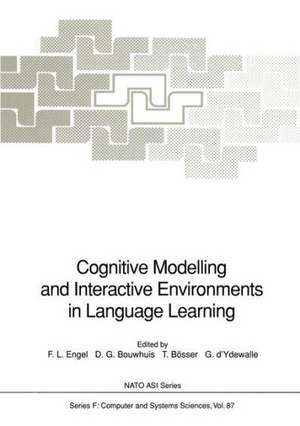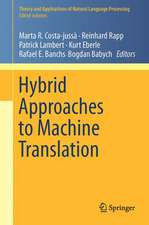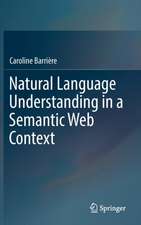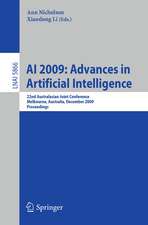Cognitive Modelling and Interactive Environments in Language Learning: NATO ASI Subseries F:, cartea 87
Editat de Frits L. Engel, Don G. Bouwhuis, Tom Bösser, Gery d' Ydewalleen Limba Engleză Paperback – 21 dec 2011
Din seria NATO ASI Subseries F:
- 20%
 Preț: 650.27 lei
Preț: 650.27 lei - 20%
 Preț: 668.55 lei
Preț: 668.55 lei - 20%
 Preț: 992.44 lei
Preț: 992.44 lei - 18%
 Preț: 1239.19 lei
Preț: 1239.19 lei - 20%
 Preț: 1922.81 lei
Preț: 1922.81 lei - 20%
 Preț: 654.37 lei
Preț: 654.37 lei - 18%
 Preț: 1234.00 lei
Preț: 1234.00 lei - 20%
 Preț: 709.78 lei
Preț: 709.78 lei - 20%
 Preț: 656.03 lei
Preț: 656.03 lei - 18%
 Preț: 1854.94 lei
Preț: 1854.94 lei - 20%
 Preț: 374.97 lei
Preț: 374.97 lei - 20%
 Preț: 991.94 lei
Preț: 991.94 lei - 20%
 Preț: 671.02 lei
Preț: 671.02 lei - 20%
 Preț: 1925.96 lei
Preț: 1925.96 lei - 20%
 Preț: 994.73 lei
Preț: 994.73 lei -
 Preț: 389.49 lei
Preț: 389.49 lei - 20%
 Preț: 657.99 lei
Preț: 657.99 lei - 20%
 Preț: 655.20 lei
Preț: 655.20 lei - 18%
 Preț: 1225.31 lei
Preț: 1225.31 lei - 18%
 Preț: 952.09 lei
Preț: 952.09 lei - 20%
 Preț: 332.06 lei
Preț: 332.06 lei - 20%
 Preț: 1284.47 lei
Preț: 1284.47 lei - 20%
 Preț: 644.81 lei
Preț: 644.81 lei -
 Preț: 395.85 lei
Preț: 395.85 lei - 18%
 Preț: 1221.07 lei
Preț: 1221.07 lei - 15%
 Preț: 643.34 lei
Preț: 643.34 lei - 20%
 Preț: 645.47 lei
Preț: 645.47 lei - 20%
 Preț: 1282.98 lei
Preț: 1282.98 lei - 20%
 Preț: 656.36 lei
Preț: 656.36 lei - 20%
 Preț: 1283.31 lei
Preț: 1283.31 lei - 20%
 Preț: 1924.15 lei
Preț: 1924.15 lei - 20%
 Preț: 362.24 lei
Preț: 362.24 lei
Preț: 649.60 lei
Preț vechi: 812.01 lei
-20% Nou
Puncte Express: 974
Preț estimativ în valută:
124.32€ • 134.99$ • 104.43£
124.32€ • 134.99$ • 104.43£
Carte tipărită la comandă
Livrare economică 22 aprilie-06 mai
Preluare comenzi: 021 569.72.76
Specificații
ISBN-13: 9783642775772
ISBN-10: 3642775772
Pagini: 332
Ilustrații: X, 310 p.
Dimensiuni: 170 x 242 x 17 mm
Greutate: 0.53 kg
Ediția:Softcover reprint of the original 1st ed. 1992
Editura: Springer Berlin, Heidelberg
Colecția Springer
Seria NATO ASI Subseries F:
Locul publicării:Berlin, Heidelberg, Germany
ISBN-10: 3642775772
Pagini: 332
Ilustrații: X, 310 p.
Dimensiuni: 170 x 242 x 17 mm
Greutate: 0.53 kg
Ediția:Softcover reprint of the original 1st ed. 1992
Editura: Springer Berlin, Heidelberg
Colecția Springer
Seria NATO ASI Subseries F:
Locul publicării:Berlin, Heidelberg, Germany
Public țintă
ResearchCuprins
1: Cognitive Modelling.- Discussion Papers.- Knowledge Acquisition and Knowledge Representation.- Cognitive Modelling and Learning.- Unraveling the Learner Model Mystery.- Contributed Papers.- Situated Cognition: A Strong Hypothesis.- Interactive Learner Performance as Evidence of Interlanguage Mapping Rules.- Generative Knowledge and the Development of Situated Know-how in Intelligent Tutoring Systems: Implications for Student Modelling.- Modelling Skill Learning.- Knowledge Acquisition for Intelligent Tutoring Systems.- Teaching Strategies in a Geometry Coaching Environment.- Training Strategies for Teaching Introductory Computer Programming.- Instructional Format Design: A Teaching Strategy to Augment Cognitive Modelling.- The Student as Expert: Personal Construct Psychology and Perceptual Recognition.- Episodic Modelling in an Intelligent Tutoring System.- Modelling Procedural Knowledge.- Three Uses of Adaptive Parsing in Intelligent Tutoring.- 2: Language Learning.- Discussion Papers.- Aids to Language Learning.- Second Language Acquisition as a Hybrid Learning Process.- Contributed Papers.- The Effectiveness of Item Selection Strategies in Paired-Associate Learning.- Interactive Ordering of Frames: With an Application to Scaling Word Difficulty.- Sequencing and Elaboration in Computer-Based Vocabulary Learning Environments.- Beginning Reading Instruction with the Aid of Computer Speech.- CALLE: A Computer-Assisted Language Learning Environment.- Knowledge Acquisition for Learner Modelling in Second Language Learning.- Watching Foreign Television Programs and Language Learning.- Syntactic Complexity Metrics and the Readability of Programs in a Functional Computer Language.- 3: Interactive Environments.- Discussion Papers.- Interactive Environments for Learning andTutoring.- Modular Prototyping in the Design of Interactive Learning Programs.- Interfaces for Learning: Motivation and the Locus of Control.- Contributed Papers.- Providing Support in Learning from Computer Simulations: Interface Aspects.- Interactive Testing.- Modelling Search Strategies in a Database Support System.- Personalized Browsing of Tutorial Material.- Item Presentation Methods for Paired-Associate Learning.- Why We Need ‘Composable’ User Interfaces.- Designing and Evaluating the Navigational Toolkit.- Cognitive Design of Educational Hypermedia: Towards a Typology of Navigation Features.- Author Index.- Data Diskettes.






















